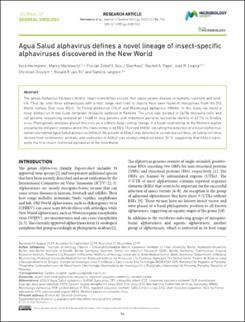Mostrar el registro sencillo del ítem
Agua Salud alphavirus defines a novel lineage of insect- specific alphaviruses discovered in the New World
| dc.contributor.author | Hermanns, Kyra | |
| dc.contributor.author | Marklewitz, Marco | |
| dc.contributor.author | Zirkel, Florian | |
| dc.contributor.author | Overheul, Gijs J. | |
| dc.contributor.author | Page, Rachel A. | |
| dc.contributor.author | Loaiza, Jose R. | |
| dc.contributor.author | Drosten, Christian | |
| dc.contributor.author | Van Rij, Ronald P. | |
| dc.contributor.author | Junglen, Sandra | |
| dc.date.accessioned | 2020-06-28T03:09:32Z | |
| dc.date.available | 2020-06-28T03:09:32Z | |
| dc.date.issued | 2020-01-01 | |
| dc.identifier.other | https://doi.org/10.1099/jgv.0.001344 | |
| dc.identifier.uri | http://repositorio-indicasat.org.pa/handle/123456789/135 | |
| dc.description | The genus Alphavirus harbours mostly insect- transmitted viruses that cause severe disease in humans, livestock and wildlife. Thus far, only three alphaviruses with a host range restricted to insects have been found in mosquitoes from the Old World, namely Eilat virus (EILV), Taï Forest alphavirus (TALV) and Mwinilunga alphavirus (MWAV). In this study, we found a novel alphavirus in one Culex declarator mosquito sampled in Panama. The virus was isolated in C6/36 mosquito cells, and full genome sequencing revealed an 11 468 nt long genome with maximum pairwise nucleotide identity of 62.7 % to Sindbis virus. Phylogenetic analyses placed the virus as a solitary deep rooting lineage in a basal relationship to the Western equine encephalitis antigenic complex and to the clade comprising EILV, TALV and MWAV, indicating the detection of a novel alphavirus, tentatively named Agua Salud alphavirus (ASALV). No growth of ASALV was detected in vertebrate cell lines, including cell lines derived from ectothermic animals, and replication of ASALV was strongly impaired above 31 °C, suggesting that ASALV represents the first insect- restricted alphavirus of the New World. | en_US |
| dc.description.abstract | The genus Alphavirus harbours mostly insect- transmitted viruses that cause severe disease in humans, livestock and wildlife. Thus far, only three alphaviruses with a host range restricted to insects have been found in mosquitoes from the Old World, namely Eilat virus (EILV), Taï Forest alphavirus (TALV) and Mwinilunga alphavirus (MWAV). In this study, we found a novel alphavirus in one Culex declarator mosquito sampled in Panama. The virus was isolated in C6/36 mosquito cells, and full genome sequencing revealed an 11 468 nt long genome with maximum pairwise nucleotide identity of 62.7 % to Sindbis virus. Phylogenetic analyses placed the virus as a solitary deep rooting lineage in a basal relationship to the Western equine encephalitis antigenic complex and to the clade comprising EILV, TALV and MWAV, indicating the detection of a novel alphavirus, tentatively named Agua Salud alphavirus (ASALV). No growth of ASALV was detected in vertebrate cell lines, including cell lines derived from ectothermic animals, and replication of ASALV was strongly impaired above 31 °C, suggesting that ASALV represents the first insect- restricted alphavirus of the New World. | en_US |
| dc.language.iso | eng | en_US |
| dc.rights | https://creativecommons.org/licenses/by-nc/4.0/legalcode | |
| dc.rights | info:eu-repo/semantics/openAccess | |
| dc.subject | insect-restricted alphavirus | en_US |
| dc.subject | mosquito | en_US |
| dc.subject | repeated sequence elements | en_US |
| dc.subject | recombination | en_US |
| dc.title | Agua Salud alphavirus defines a novel lineage of insect- specific alphaviruses discovered in the New World | en_US |
| dc.type | info:eu-repo/semantics/article | en_US |
| dc.type | info:eu-repo/semantics/publishedVersion |

